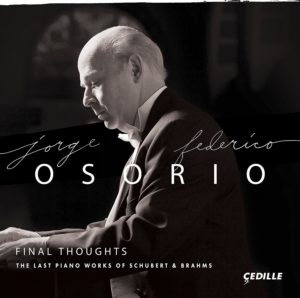A generous feast: All of Brahms’ last piano pieces bracketed in between Schubert’s last two sonatas, performed by a musicianly virtuoso, captured in intimately close yet amply robust sonics. Jorge Federico Osorio’s mastery beckons your attention. The Schubert D. 959 A major sonata’s sprawling first movement receives a fluid and intelligently nuanced reading, followed by an Andantino that assiduously builds up to and decompresses after its shattering central climax. The scherzo’s easy lilt and winsomely varied chord arpeggiations justify a more easygoing, less precipitous tempo than usual. While the Rondo finale doesn’t quite match Pollini’s winged poetry, one cannot ignore Osorio’s firm left-hand underpinning and clear voice leading.
At times his rhythmic inflections in the D. 960 B-flat sonata Molto moderato’s exposition pull focus from the narrative flow, yet these gestures still sound internalized and well considered. In contrast, Osorio unifies his expansive conception of the Andante sostenuto with a hypnotic, resolutely steady accompanying ostinato figure. The Scherzo is curvy and playful, as Osorio leaves you guessing as to which of the Trio’s off-beat bass notes he will accent. On the other hand, the left-hand syncopations in the Rondo’s second theme recede too much in the background, although once the tumultuous minor-key theme kicks in, Osorio’s poetic and dramatic powers decisively click into focus.
In the main, Osorio’s late Brahms charts a direct path that differs from Arcadi Volodos’ poetic ruminations. Compare, for example, Volodos’ discursive rendering of Op. 117 No. 1’s central episode alongside Osorio’s comparatively stronger rhythmic delineation of the same passage and you’ll hear what I mean. Still, Osorio offers illuminating rhetorical touches: notice his yearning hesitation on certain of Op. 119 No. 2’s upbeats, Op. 118 No. 4’s thoughtful contrapuntal interplay between the hands with barely a trace of pedal, the pinpointed control of Op. 116 No. 5’s short phrases, not to mention the strong tenor voice presence in Op. 116 No. 6. And his angular parsing of Op. 117 No. 3’s main theme underlines the music’s unsettled qualities that more than a few pianists too willingly flatten out. Even in a catalog crowded with excellent recordings of these works, Osorio’s cultured artistry offers much to savor over repeated hearings.
































